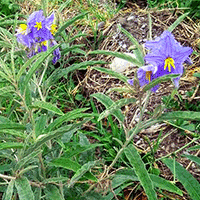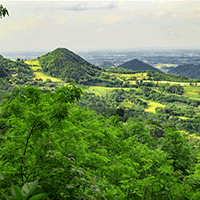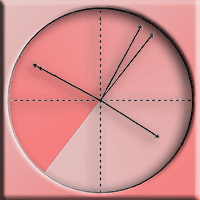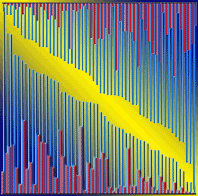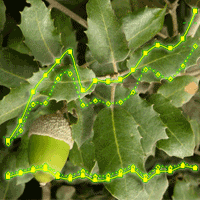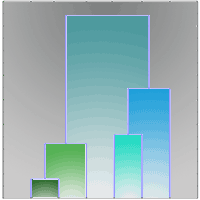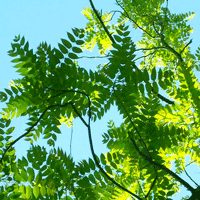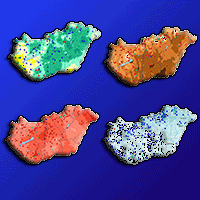Solanum elaeagnifolium Cav. is one of the most invasive plant species worldwide that colonizes crops and human disturbed lands, while it appears at the edge of forest ecosystems. Its control still remains an unsolved problem around the world. Understanding its distribution under predicted climate change, could contribute to an effective management and conservation of ecosystems in the future. This research was conducted in order to investigate the capacity of this species to invade Mediterranean forest ecosystems, and if the allelopathy effects of forest tree species could control its regeneration, thus contributing to a natural and biological management practice aimed to prevent the species from pervading into Mediterranean forest ecosystems. Results showed that S. elaeagnifolium can establish itself outside and along the forest edges, but not in a typical forest environment. The leaf extracts of Pinus brutia, Cupressus sempervirens, Quercus coccifera and Quercus pubescens significantly inhibited the germination of S. elaeagnifolium. Root regenerative ability of the cuttings was also significantly affected by the leaf extract treatments. P. brutia leaf extract had significantly the highest inhibitory activity on root regenerative ability of the species. Despite the promising findings of this study, absence of S. elaeagnifolium in Mediterranean forest ecosystems can be attributed to a combination of factors. In the context of climate change, especially in hot and dry Mediterranean areas, and the expected increase of forest disturbances (e.g., fires), the findings of the study could contribute towards the restriction of this invasive alien species by an appropriate management of forest ecosystems.
Keywords
, , , ,
Citation
Formozis G, Tsakaldimi M, Ganatsas P (2021). Are Mediterranean forest ecosystems under the threat of invasive species Solanum elaeagnifolium?. iForest 14: 236-241. - doi: 10.3832/ifor3706-014
Academic Editor
Federica Brunoni
Paper history
Received: Nov 27, 2020
Accepted: Mar 25, 2021
First online: May 10, 2021
Publication Date: Jun 30, 2021
Publication Time: 1.53 months
© SISEF - The Italian Society of Silviculture and Forest Ecology 2021
Open Access
This article is distributed under the terms of the Creative Commons Attribution-Non Commercial 4.0 International (https://creativecommons.org/licenses/by-nc/4.0/), which permits unrestricted use, distribution, and reproduction in any medium, provided you give appropriate credit to the original author(s) and the source, provide a link to the Creative Commons license, and indicate if changes were made.

Breakdown by View Type
(Waiting for server response...)
Article Usage
Total Article Views: 35074
(from publication date up to now)
Breakdown by View Type
HTML Page Views: 29806
Abstract Page Views: 2304
PDF Downloads: 2401
Citation/Reference Downloads: 2
XML Downloads: 561
Web Metrics
Days since publication: 1666
Overall contacts: 35074
Avg. contacts per week: 147.37
Article Citations
Article citations are based on data periodically collected from the Clarivate Web of Science web site
(last update: Mar 2025)
Total number of cites (since 2021): 4
Average cites per year: 0.80
Publication Metrics
by Dimensions ©
Articles citing this article
List of the papers citing this article based on CrossRef Cited-by.
(1)
Adhikari P, Jeon JY, Kim HW, Shin MS, Adhikari P, Seo C (2019)Potential impact of climate change on plant invasion in the Republic of Korea. Journal of Ecology and Environment 43 (1): 36.
CrossRef |
Gscholar
(2)
Alrababah MA, Tadros MJ, Samarah NH, Ghosheh H (2009)Allelopathic effects of
Pinus halepensis and
Quercus coccifera on the germination of Mediterranean crop seeds. New Forests 38: 261-272.
CrossRef |
Gscholar
(3)
Baye Y, Ameur A, Bouhaches M, Taleb A (2007)Strategy for the chemical control of
Solanum elaeagnifolium Cav. in Morocco. EPPO Bulletin 37: 145-152.
CrossRef |
Gscholar
(4)
Boyd JW, Murray DS (1982a)Growth and development of Silverleaf nightshade (
Solanum elaeagnifolium). Weed Science 30: 238-243.
CrossRef |
Gscholar
(5)
Boyd JW, Murray DS (1982b)Effects of shade on Silverleaf nightshade (
Solanum elaeagnifolium). Weed Science 30: 264-269.
CrossRef |
Gscholar
(6)
Brunel S, Schrader G, Brundu G, Fried G (2010)Emerging invasive alien plants for the Mediterranean Basin. OEPP/EPPO Bulletin 40: 219-238.
CrossRef |
Gscholar
(7)
Brunel S (2011)Pest risk analysis for
Solanum elaeagnifolium and international management measures proposed. EPPO Bulletin 41: 232-42.
CrossRef |
Gscholar
(8)
Bulut Y, Demir M (2007)The allelopathic effects of Scots Pine (
Pinus sylvestris L.) leaf extracts on turf grass seed germination and seedling growth. Asian Journal of Chemistry 19 (4): 3169-3177.
Online |
Gscholar
(9)
Cambardella CA, Elliott ET (1992)Particulate soil organic-matter changes across a grassland cultivation aequence. Soil Science Society of America Journal 56: 777-783.
CrossRef |
Gscholar
(10)
Chen J, Franklin JF, Spies TA (1995)Growing-season microclimatic gradients from clearcut edges into old-growth Douglas-fir forests. Ecological Applications 5: 74-86.
CrossRef |
Gscholar
(11)
Choudhary M, Bordovsky DG (2006)Timing of glyphosate application on control of Silverleaf nightshade and glyphosate-resistant cotton yield. Weed Technololgy 20: 198-203.
CrossRef |
Gscholar
(12)
Christodoulakis NS, Lampri PN, Fasseas C (2009)Structural and cytochemical investigation of the leaf of silverleaf nightshade (
Solanum elaeagnifolium), a drought-resistant alien weed of the Greek flora. Australian Journal of Botany 57: 432-438.
CrossRef |
Gscholar
(13)
Cummings J, Parker I, Gilbert G (2012)Allelopathy: a tool for weed management in forest restoration. Plant Ecology 213 (12): 1975-1989.
CrossRef |
Gscholar
(14)
Davies-Colley RJ, Payne GW, Van Elswijk M (2000)Microclimate gradients across a forest edge. New Zealand Journal of Ecology 24: 111-121.
Online |
Gscholar
(15)
EPPO (2007)Datasheets on quarantine pests.
Solanum elaeagnifolium. EPPO Bulletin 37: 236-245.
CrossRef |
Gscholar
(16)
Fernandez C, Lelong B, Vila B, Mevy JP, Robles C, Greff S, Dupouyet S, Bousquet-Melou A (2006)Potential allelopathic effect of
Pinus halepensis in the secondary succession: an experimental approach. Chemoecology 16: 97-105.
CrossRef |
Gscholar
(17)
Ganatsas P, Tsitsoni T, Tsakaldimi M, Zagas T (2012)Reforestation of degraded Kermes oak shrublands with planted pines: effects on vegetation cover, species diversity and community structure. New Forests 43: 1-11.
CrossRef |
Gscholar
(18)
Ganatsas P, Tsakaldimi M, Damianidis C, Stefanaki A, Kalapothareas T, Karydopoulos T, Papapavlou K (2019)Regeneration ecology of the rare plant species
Verbascum dingleri: implications for species conservation. Sustainability 11 3305: 1-13.
CrossRef |
Gscholar
(19)
Gitsopoulos TK, Damalas CA, Georgoulas I (2017)Chemical options for the control of Silverleaf nightshade (
Solanum elaeagnifolium). Planta Daninha 35: e017162035.
CrossRef |
Gscholar
(20)
Hashim A, Mousawi A, Al-Naib F (1975)Allelopathic effects of
Eucalyptus microtheca F. Muell. Kuwait Journal of Science 2: 59-66.
Gscholar
(21)
Honnay O, Verheyen K, Hermy M (2002)Permeability of ancient forest edges for weedy plant species invasion. Forest Ecology and Management 161: 109-122.
CrossRef |
Gscholar
(22)
ISTA (2020)International rules for seed testing. The International Seed Testing Association - ISTA, Bassersdorf, Switzerland. pp. i-19-8.
Gscholar
(23)
Khaniya L, Shrestha BB (2020)Forest regrowth reduces richness and abundance of invasive alien plant species in community managed
Shorea robusta forests of central Nepal. Journal of Ecology and Environment 44: 12.
CrossRef |
Gscholar
(24)
Krigas N, Votsi NE, Katsoulis G, Tsiafouli M (2016)Climate creates limitations, soil disturbance favours and roads pave the way for the invasion of
Solanum elaeagnifolium CAV. (Solanaceae), even in protected areas. In: Proceedings of the “8th Congress of the Hellenic Ecological Society: 150+ Years of Ecology-Structures, Dynamics and Survival Strategies”. Thessaloniki (Greece) 20-23 Oct 2016. Hellenic Ecological Society, Greece, pp. 127.
Gscholar
(25)
Langmaier M, Lapin K (2020)A systematic review of the impact of invasive alien plants on forest regeneration in European temperate forests. Frontiers in Plant Science 11: 1974.
CrossRef |
Gscholar
(26)
Levia DF, Herwitz SR (2005)Interspecific variation of bark water storage capacity of three deciduous tree species in relation to stemflow yield and solute flux to forest soils. Catena 64: 117-137.
CrossRef |
Gscholar
(27)
Lill RE, Waid JS (1975)Volatile phytotoxic substances formed by litter of
Pinus radiata. New Zealand Journal of Forestry Science 5: 165-170.
Online |
Gscholar
(28)
Limin SG, Oue H, Sato Y, Budiasa IW, Setiawan BI (2015)Partitioning rainfall into throughfall, stemflow, and interception loss in clove (
Syzygium aromaticum) plantation in Upstream Saba River Basin, Bali. Procedia Environmental Sciences 28: 280-285.
CrossRef |
Gscholar
(29)
Mekki M (2006)Potential threat of
Solanum elaeagnifolium Cav. to the Tunisian fields. In: Proceedings of the “International Workshop: Invasive Plants in Mediterranean Type Regions of the World”. Mèze (France) 25-27 May 2005. Council of Europe publishing, Strasbourg, France, pp. 165-170. -
Online |
Gscholar
(30)
Mekki M (2007)Biology, distribution and impacts of Silverleaf nightshade (
Solanum elaeagnifolium Cav.). EPPO Bulletin 37: 114-118.
CrossRef |
Gscholar
(31)
Morgan EC, Overholt WA (2005)Potential allelopathic effects of Brazilian pepper (
Schinus terebinthifolius Raddi, Anacardiaceae) aqueous extract on germination and growth of selected Florida native plants. The Journal of the Torrey Botanical Society 132: 11-15.
CrossRef |
Gscholar
(32)
Owens MK, Lyons RK, Alejandro CL (2006)Rainfall partitioning within semiarid juniper communities: effects of event size and canopy cover. Hydrological Processes 20: 3179-3189.
CrossRef |
Gscholar
(33)
Pauchard A, Alaback PB (2006)Edge type defines alien plant species invasions along
Pinus contorta burned, highway and clearcut forest edges. Forest Ecology and Management 223: 327-335.
CrossRef |
Gscholar
(34)
Phillips ML, McNellis BE, Allen MF, Allen EB (2019)Differences in root phenology and water depletion by an invasive grass explains persistence in a Mediterranean ecosystem. American Journal of Botany 106 (9): 1210-1218.
CrossRef |
Gscholar
(35)
Rice EL (2012)Allelopathy (2nd edn). Academic Press, New York, USA, pp. 368.
Online |
Gscholar
(36)
Roche C (1991)Silverleaf nightshade. Publication no. 365, Pacific Northwest Extension, Washington State University, Pullman, WA, USA, pp. 5-6.
Gscholar
(37)
Sayari N, Brundu G, Mekki M (2016)Mapping and monitoring an invasive alien plant in Tunisia: Silverleaf nightshade (
Solanum elaeagnifolium) a noxious weed of agricultural areas. Tunisian Journal of Plant Protection 11: 219-227.
Online |
Gscholar
(38)
Scavo A, Mauromicale G (2020)Integrated weed management in herbaceous field crops. Agronomy 10 (4): 466.
CrossRef |
Gscholar
(39)
Scavo A, Pandino G, Restuccia A, Mauromicale G (2020)Leaf extracts of cultivated cardoon as potential bioherbicide. Scientia Horticulturae 261 (2): 109024.
CrossRef |
Gscholar
(40)
Scognamiglio M, D’Abrosca B, Esposito A, Pacifico S, Monaco P, Fiorentino A (2013)Plant growth inhibitors: allelopathic role or phytotoxic effects? Focus on Mediterranean biomes. Phytochememistry Reviews 12: 803-830.
CrossRef |
Gscholar
(41)
Sforza R, Jones WA (2007)Potential for classical biocontrol of silverleaf nightshade in the Mediterranean Basin. EPPO Bulletin 37: 156-162.
CrossRef |
Gscholar
(42)
Singh D, Kohli RK (1992)Impact of
Eucalyptus tereticornis Sm. shelterbelts on crops. Agroforestry Systems 20: 253-266.
CrossRef |
Gscholar
(43)
Stanton RA, Heap JW, Carter RJ, Wu H (2007)Solanum elaeagnifolium. OEPP/EPPO Bulletin 37: 236-245.
CrossRef |
Gscholar
(44)
Stanton R, Wu H, Lemerle D (2011)Root regenerative ability of Silverleaf nightshade (
Solanum elaeagnifolium Cav.) in the glasshouse. Plant Protection Quarterly 26: 54-56.
Gscholar
(45)
Stanton R, Wu H, Lemerle D (2012)Factors affecting Silverleaf nightshade (
Solanum elaeagnifolium) germination. Weed Science 60: 42-47.
CrossRef |
Gscholar
(46)
Sturm DJ, Peteinatos G, Gerhards R (2018)Contribution of allelopathic effects to the overall weed suppression by different cover crops. Weed Research 58 (5): 331-337.
CrossRef |
Gscholar
(47)
Thapa S, Chitale V, Rijal SJ, Bisht N, Shrestha BB (2018)Understanding the dynamics in distribution of invasive alien plant species under predicted climate change in Western Himalaya. PLoS One 13(4): e0195752.
CrossRef |
Gscholar
(48)
Tolliver KS, Colley DM, Young DR (1995)Inhibitory effects of
Myrica cerifera on
Pinus taeda. The American Midland Naturalist Journal 133: 256-263.
CrossRef |
Gscholar
(49)
Uludag A, Gbehounou G, Kashefi J (2016)Review of the current situation for
Solanum elaeagnifolium in the Mediterranean Basin. EPPO Bulletin 46: 139-147.
CrossRef |
Gscholar
(50)
Van Dijk AIJ, Bruijnzeel LA (2001)Modelling rainfall interception by vegetation of variable density using an adapted analytical model. Part 1. Model description. Journal of Hydrology 247: 230-238.
CrossRef |
Gscholar
(51)
Vila M, Weiner J (2004)Are invasive plant species better competitors than native plant species? - evidence from pair-wise experiments. Oikos 105: 229-238.
CrossRef |
Gscholar
(52)
Young A, Mitchell N (1994)Microclimate and vegetation edge effects in a fragmented podocarp broadleaf forest in New Zealand. Biological Conservation 67: 63-72.
CrossRef |
Gscholar
(53)
Zhang J, An M, Wu H, Liu DL, Stanton R (2012)Chemical composition of essential oils of four Eucalyptus species and their phytotoxicity on Silverleaf nightshade (
Solanum elaeagnifolium Cav.) in Australia. Plant Growth Regulation 68: 231-237.
CrossRef |
Gscholar
